to a T review
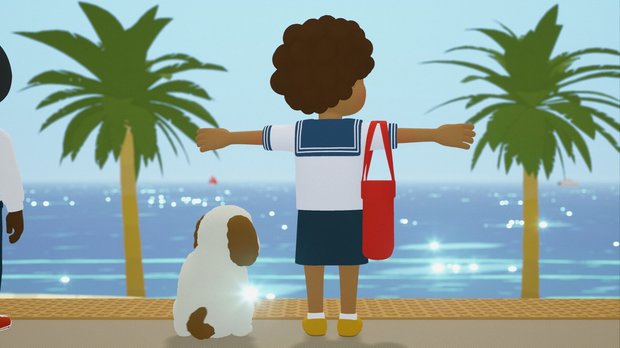
- 0 Comments
Quirky adventure from the designer of Katamari Damacy perfectly suited to those looking for a charming, message-positive experience
Every so often, I get the joy of playing something so ridiculously offbeat and heartfelt that it breathes new life into my love for video games, and I’m happy to tell you I’ve just experienced it again with to a T. With Keita Takahashi, famed creator of Katamari Damacy, at the helm of his development studio uvula, you could pretty much guarantee it was going to be cute and whimsical, but just how touching and earnest it is came as a very welcome surprise. The game is marketed as a puzzle-adventure, but the puzzle element definitely takes a backseat to the wonderful narrative displayed here, full of twists and turns, wacky happenings and a very sincere message. Fans of unconventional tales will likely enjoy this, and to a T has such a huge heart at the centre of it, you can’t help but be swayed by its family friendly charm.
At its core, to a T is about disability and accessibility for a young person in a nondisabled world. That may sound like a heavy topic, but the way the game tackles it is subtle yet powerful, never feeling too heavy-handed and always with a positive touch. There are a few pacing issues, a clunky navigation system and a narrative that (for better or worse) goes completely off the rails before the end, but I came away from the experience with a feeling of warmth and a general joie de vivre that had me smiling for the rest of the day.
This is the story of Teen, a young person stuck navigating their world in a perpetual T-shape, arms permanently outstretched to the sides. Teen’s sidekick is the ever-present Dog, who acts as a faithful service animal, helping Teen and providing an extra ‘aww’ factor. Teen’s journey begins in a frightening way, dressed in pyjamas and trying to outrun a tornado in an introductory sequence that serves as a character creation segment. Teen’s skin tone, hairstyle and colour can be selected from about half a dozen options, though interestingly there is no choice of gender and none of the options lend themselves to being overly gender-specific which I thought was a neat touch. There is also the option to change Teen’s name, but I stuck with the default.
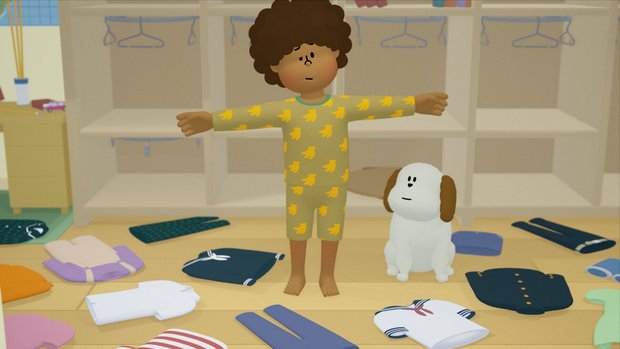
After being saved from the tornado by Teen’s unique shape, it is revealed that all is well and this was just a nightmare. The game then launches into one of the songs that will soon become very familiar (and an earworm for me!) during a cute montage of the town and cast of characters who will be accompanying Teen on their adventure. More on the music later, but suffice to say that this song called “You Are the Perfect Shape” already had the tears prickling in my eyes.
Teen’s first job is to name the dog if you wish (I didn’t). Not quite as simple is the process of petting Dog, which involves Teen rotating their body 90 degrees and then angling their body down so that their hand touches the pup’s head. This, as a first foray into adapting Teen’s unique circumstances to do the “small things,” felt very impactful.
Next, Teen has a bathroom emergency, offering the first glimpse into to a T’s slapstick style. Dog helps Teen navigate to the toilet and there is a quick time event in order to complete Teen’s business. Various button prompts appear on-screen, flashing up randomly and appearing faster as the event goes on, accompanied by various noises and screen shakes. There is no penalty if you miss a prompt and certainly no fail state if you decide not to partake in this particular activity; you can choose to flush at any time. The whole scene is incredibly silly and serves as comic relief that really sets up the tone of the game. It is light-hearted and joyful, but the fact that Dog has to help Teen access this basic need alludes to the undercurrent that runs throughout: being different.
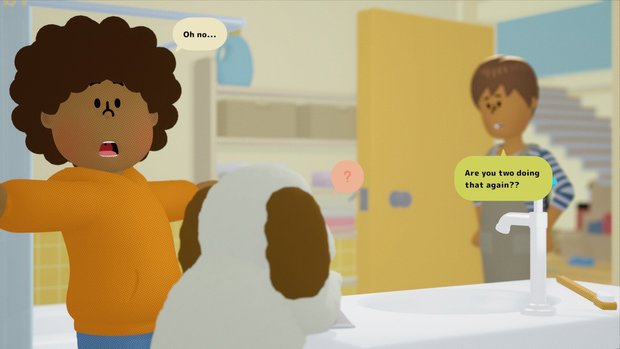
Teen then needs a change of clothing, aided again by the ever-helpful Dog. This is another fun bit of customisation to set up the day ahead, with a handful of clothing options available to select from. Choose something and Dog will grab it from the rail and throw it at Teen, though we are never privy to the logistical challenges of how Teen gets dressed as the change is instant. Far too late in the game, I realised that there are also options for Dog, like a little baseball cap, which is ridiculously cute.
Heading downstairs to greet Teen’s mother Niko and continue with their daily routine, Teen is instructed to have some breakfast, wash their face, brush their teeth and pick out their school shoes and a bag from the closet. This set of actions is repeated throughout the game’s eight chapters, but it didn’t feel repetitive to me and I loved changing Teen’s outfits every time I had the opportunity to. You’re rewarded when eating breakfast with unusual combinations of flavours (mango milk, anyone?) and learning about the adventures of Teen’s favourite character King Pig, the cereal mascot. I kept looking forward to seeing what the next weird flavour profile Teen would have for breakfast and found it utterly charming.
Teen’s home is adaptive and accessible, thanks to things like a specially installed faucet that shoots water up with a push of a button, an extra-long spoon that doesn’t require the ability to bend one’s arm, and a toothbrush system involving Dog dispensing the toothpaste, which works perfectly. However, even these things aren’t easy to use, and this is where to a T does an excellent job of highlighting the genuine difficulties Teen faces. Younger players will enjoy the silliness of how Teen has to manoeuvre their body, but adult players may find themselves taking a pause here with a brief moment of reflection.
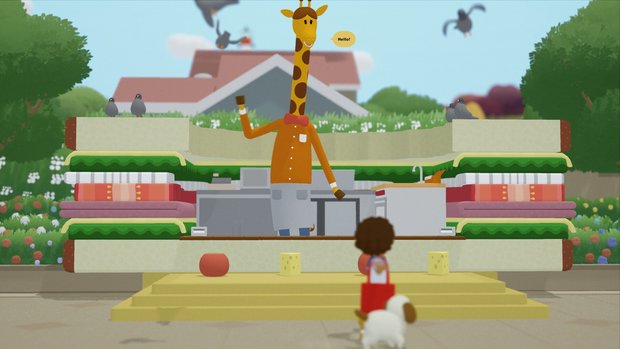
On a Steam Deck (a gamepad is recommended), Teen’s arms and hands are controlled independently using the joysticks and bumpers. Just to pick up the cereal box while seated at the table, I had to manoeuvre Teen’s arm, which moved the whole body to a position near the cereal on the right side of the screen and grab it using Teen’s hand. Then I had to carefully pour the cereal into the bowl, trying not to spill any over the sides, then do the same with the milk on the left side. When Teen manages to fill their bowl up to the game’s satisfaction, it’s time to chow down, but as you may have guessed, this isn’t exactly straightforward either. Teen must bend forward to the bowl to scoop up the contents, straighten up, then bend at the neck to reach the spoon so they can eat.
The actions themselves go on for a couple of beats longer than you might expect them to. Some are simply for comedic effect, such the long, drawn-out stream of water Teen expels from their mouth after rinsing their teeth, but others serve to highlight that although Teen can do these things with the help of adaptive components, they can simply take a disabled person longer, such as washing their face using only a stream of water. These parts are clearly intentional, but still subtle; a real testament to how to a T doesn’t bash the player over the head with its message.
Even on their 13th birthday, Teen has to go to school and the mood shifts dramatically. Teen has been getting bullied due to their unique shape, and they suddenly become withdrawn, walking slowly and with a dejected look on their face. After the bright and chipper intro sequence, the now sad and worried slow walk to school feels sorrowful. (For any parents worrying about how bullying is depicted in this game, it’s fairly light: the trio of bullies walk around with their arms outstretched in a mimicking fashion or leave books on Teen’s desk in the shape of a T.) When Teen finally arrives, the school transforms into a monster in Teen’s mind, which feels relatable.
Teen’s school days are split up into classes: maths, science and physical education, each with their own themed mini-game. Maths is a series of equations, physical education is a very fun but tricky rhythm-based challenge, and science has Teen making a dark magic concoction to change their skin colour, which lasts for the rest of the chapter. Free time has Teen running around the town, exploring and collecting little pink coins called “hospas.” As the game unfolds, these hospas can be spent at a couple of stores for different clothing options, hairstyles, and on other games found throughout town when interacting with particular characters. Word to the wise: these games are not easy, and I never made it to the top of any in-game leaderboards.
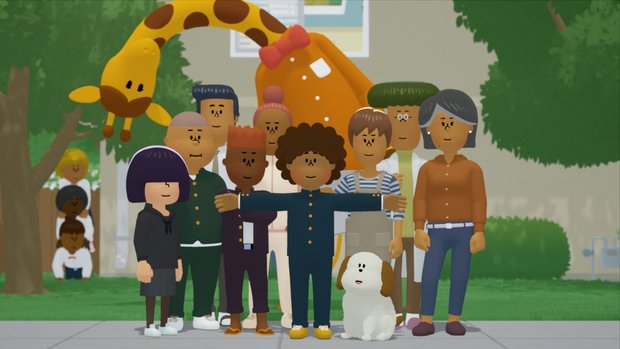
Depending on how much time you spend on optional activities, the story of Teen and Dog moves at a fairly rapid pace. Each chapter opens new locations, new characters, and in some, new abilities. However, I found that moving through the chapters didn’t feel as cohesive as it could have. At the beginning of the game, to a T feels very much like a full life sim: get up, eat, choose clothes, go to school, collect coins, learn more about the world. As the chapters advance, the game seems to pick and choose which parts will be included – less a regular pattern and more random with lots of new ideas and concepts thrown in.
The story heads firmly in the direction of the absurd as to a T’s chapters tick on, introducing fantastical sci-fi elements that have both personal meaning to Teen and wider implications for the entire town. I don’t want to risk spoiling anything, because it has to be seen to be believed. (Really!) That’s not to say the plot is bad, making complete sense in its own weird way. It’s just offbeat and ludicrous. I’m glad the developers made it as silly as they did, though, because it makes the experience much more memorable. At one point even Dog gets a starring role, donning a Sherlock Holmes-inspired hat after getting lost in town for a very enjoyable segment that could have come straight out of an Aesop’s Fable. Importantly, as crazy as things get, they never lose sight of the game’s underlying theme of accepting personal differences.
Even if the protagonist wasn’t shaped like a T, navigation would be a mixed bag. The game is in 3D with a fixed camera perspective, which works very well until it comes to roaming the town. In a few instances Dog will lead Teen to a specific place, which is great, but if Teen wants to go off exploring the shops or needs to find a specific character, this is when things fall apart. As I was moving, the camera would cut to an angle that was sometimes at odds with the direction I thought Teen was going. This forced me to frequently open the in-game map to reorient myself, then backtrack only to turn around and scratch my head again because it just wasn’t making any sense. It’s less of an issue after playing for a while and learning the layout of the town, but certainly when attempting to navigate a new unlocked area, it’s far more difficult than it needs to be.
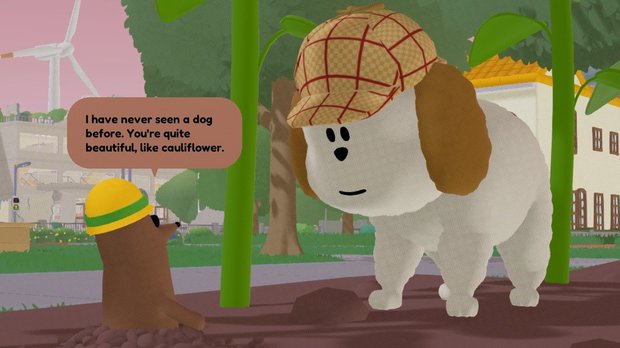
Other than the camera issues, running around town is fun. At first I tried to walk with consideration of other characters because they were constantly asking Teen to watch out and being caught by Teen’s arms, slowing Teen down. However, as the story progressed and both Teen and I grew in confidence about our unique shape, I started barging straight through the crowds in a cavalier fashion with the mindset of, “You could also move, you know,” exasperated with having to make allowances for people who weren’t making allowances for Teen.
Eventually Teen gets access to a unicycle, which is such a perfect choice. What other vehicle would be as fitting for someone in a perpetual arms-out pose? Luckily, you can’t do damage to yourself or others when riding the unicycle, which is just as well as Teen (well, I) drove recklessly without due care or attention. In a later chapter, Teen discovers that they have a special talent of spinning around really fast, which they hone by training with their physical education teacher. (There’s only one accessibility change you can make in to a T, preventing you from having to spin the joystick here.) This can be used to gain access to previously inaccessible areas. However, not much is made of this newfound ability, to the point that I forgot I had it. It is needed for a couple of plot points and then never mentioned further. I wish it had been expanded upon, because it felt like something significant when introduced but then was all but forgotten.
At various times, Teen and other characters speak directly to the player, breaking the fourth wall. “The Chorus” you’ll meet at the beginning of the game; these three identically dressed characters sum up events looking right into the camera – one of several different references to classical Greek theatre. The Chorus aren’t the only entertaining personalities in this tale, however. There are also four giraffes (all called Giraffe) who own and operate various food and snack venues, a trio of Teen’s classmates who go through their own redemption arc, Teen’s mum and aunt who provide vital backstory, a few of Teen’s teachers who are supportive yet unhinged, and various animals and critters who turn up in Dog’s starring segment.
Character models and backgrounds are done in a clean, simplistic cartoon style, with everything bright and whimsical. In the options screen, to a T offers a wealth (17!) of optional graphical filters ranging from Noir to CRT TV and everything in between. The use of gently flashing lights and sparkles on items such as Teen’s wardrobe give it some pizzazz and stop it from feeling too flat. The animation is very smooth, with a lot of attention to the “little things.” For example, Teen will open a door awkwardly due to their shape but will kick it closed afterward. Every action has a small animation, from putting on Teen’s school shoes to making a sandwich, and many of the cutscenes and interactions involve movement. Text is displayed in speech bubbles that are easy to read on-screen, accompanied by speaking sounds that seem like they could belong to a real language but don’t.
As one might expect from the developer of Katamari Damacy, the soundtrack is sublime. Catchy, cute and fun are the order of the day. Earlier I mentioned the song called “You Are the Perfect Shape,” which you will hear between chapters or just because, but even after hearing it for what must have been the tenth time by the end of the game, I was still singing along to this cheerful pop melody. There is another song (performed by the creator of Steven Universe, Rebecca Sugar) that plays just as frequently and is just as catchy. As the story progresses, these songs remain the same but the accompanying cutscenes change ever-so-slightly, which really brought me joy. The background music in between is very pleasant, full of piano tinkles and violin melodies as part of a score that is optimistic, hopeful and highly polished.
Clocking in at around five hours for my playthrough, to a T is a fairly short game. I didn’t do many of the optional objectives, however, such as collecting all the hospas or finding all the hairstyles for a barber shop crab, which I’d imagine would add on an hour or so more. After a highly surreal last chapter, the ending lands convincingly by tying all loose ends neatly with a satisfying bow.
Final Verdict
If you couldn’t tell, I really enjoyed my time with this game. Sometimes stories that weave a narrative about disability can be trite, full of tropes and all about “overcoming adversity,” which ultimately feels performative. Not so the case here, in a story about acceptance and celebration of differences that feels authentically earnest. Coupled with a wonderful soundtrack and an attractive cartoon look, to a T is great for young and older audiences alike. Some frustrating camera work knocks a bit of the shine off, and the mini-games and mazes may not the ideal “puzzle” experience you may be looking for, but in all other respects, to a T is so charming in its eccentricities that you’ll likely forgive and forget all about them.
Hot take
A wonderfully surreal and heartfelt narrative adventure, to a T delightfully reinforces the important message that regardless of our perceived personal limitations, we are all “the perfect shape.”
Pros
- Charming, whimsical cartoon artwork
- Catchy songs and a perfectly suited musical score
- Family friendly fun with an important underlying message
- Dog is a fantastic – and necessary – companion
Cons
- Fixed camera angles can be clunky and confusing
- One gameplay element is almost forgotten
Victoria played to a T on the Steam Deck using a review code provided by the game's publisher.



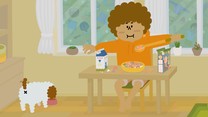



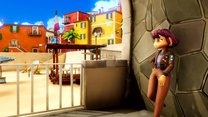



0 Comments
Want to join the discussion? Leave a comment as guest, sign in or register.
Leave a comment